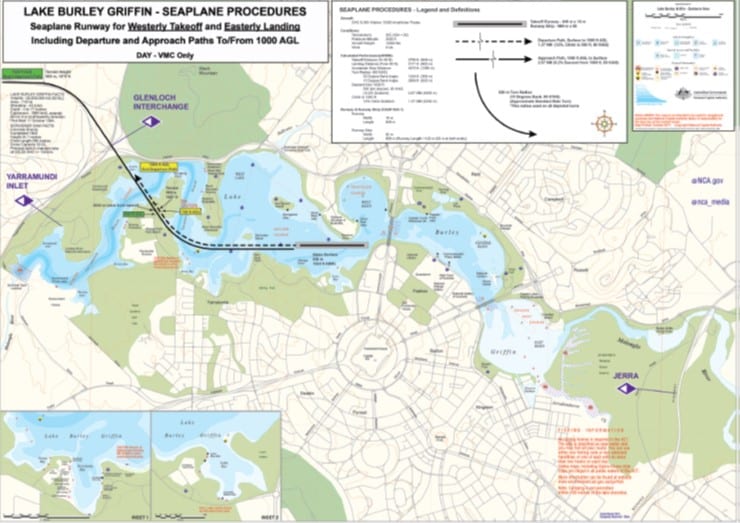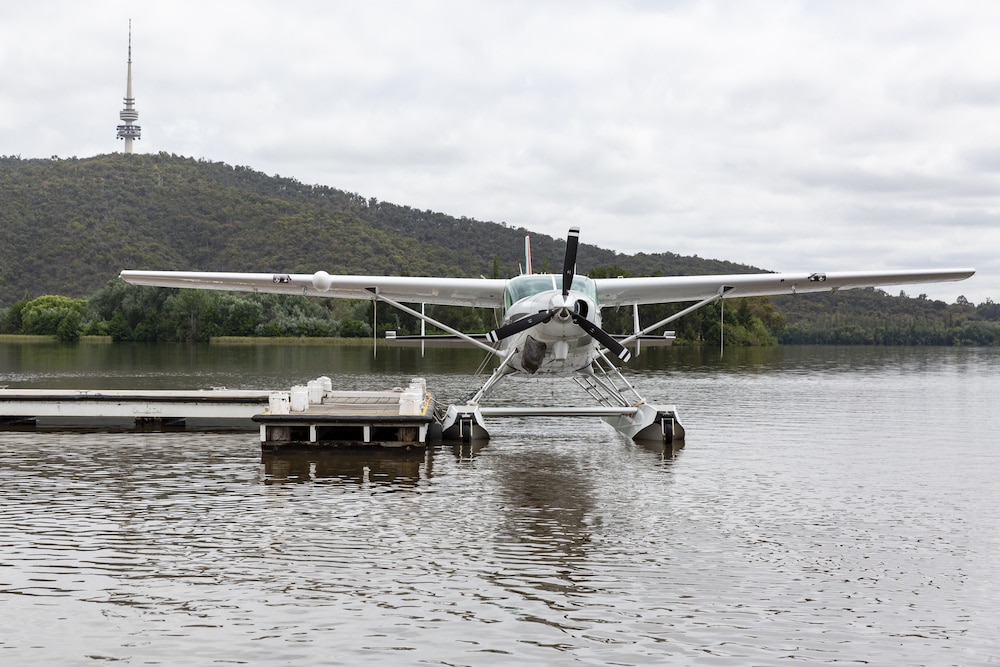In preparation for seaplanes coming to Lake Burley Griffin next year, the National Capital Authority has invited users of the lake to a workshop on Wednesday to finetune a new safety guide.
Last year, the NCA approved the use of the lake as a landing spot for seaplanes from Sydney and the NSW South Coast.
- Seaplanes to Sydney and the South Coast (22 December 2021)
- Harbour-to-lake seaplane commute may be possible next year (15 December 2020)
Sydney Seaplanes, the largest seaplane operator in Australia, intends to fly commuter services between the lake and Rose Bay, Sydney (arriving in Canberra at 10am and 3.30pm, leaving Canberra at 10.30am and 4pm), and between Canberra Airport and Sydney (mornings and evenings). South Coast Seaplanes would offer scenic flights around Canberra.
The NCA considers seaplanes as another recreation activity for the manmade lake, NCA CEO Sally Barnes said today – one that would create a buzz around Canberra, and offer an alternative way for people to get to their national capital.
“We see Canberra as a place for all Australians. We think as many Australians [as possible] should come to Canberra and experience their national capital. We see this as an additional way to get to Canberra.”
When NCA made its decision in December, Chief Minister Andrew Barr and the Canberra Region Tourism Leaders’ Forum supported the proposal, arguing it would boost tourism and benefit the ACT economy.
But many Canberrans did not want seaplanes landing on their lake. Of 102 public submissions, 72 opposed the proposal; the Canberra Yacht Club and the Lake Burley Griffin Guardians worried seaplanes would endanger lake users, make lake-based sporting clubs unviable, and pollute the lake. Sydney Seaplanes plans to become all-electric and zero-emissions by 2025, while the NCA states that the seaplanes are likely to be audible but not disturbing.
The NCA reiterated its support today for seaplane operations if safety, licence, and infrastructure requirements are met. It states that it has balanced the requirements of the lake users with safety and heritage requirements. The number of seaplane operations each day will be limited; and it has carefully considered the location of the seaplane landing and take-off sites and infrastructure.
For instance, it has ruled out Central and East Basin for seaplane operations. Central Basin forms part of the heritage-listed Parliament House vista, and could be unsafe, while seaplanes would disturb East Basin’s tranquillity; that basin is also too shallow, has too many logs in the water, and is used by dragon boats and rowers.
Instead, the seaplanes will use the West Basin, mooring at a floating pontoon the NCA will build on Acton Peninsula, at the eastern side of the National Museum of Australia. The seaplanes will land on the water, motor around, then passengers will disembark at the Museum.


“Every time we put anything on the lake, people love it – markets, kiosks, Regatta Point, paddleboats,” Ms Barnes said. “They love being out, they love seeing things happening … they like colour and movement. I should say we get more complaints over not enough happening on the lake than we do about too much happening on the lake.”
Tomorrow’s workshop will address lake users’ concerns raised during the consultation process on the shared and safe use of the lake, the NCA said. It has invited 70-plus lake users to the event to finalise the Lake User Guide, which Ms Barnes intends will be “the one-stop shop for the lake”.
The Guide will provide guidance on governing regulations; permitted and prohibited activities; information on new legislation; seaplane operations; requirements for boats; boat and mooring permits, agreements, and approvals. This will be the first time there has been such a comprehensive document about the use of the lake.
The NCA wants the lake users to tell the NCA what they think of the guide, “what’s missing, what other ideas do they need to put in, what would be helpful for them,” Ms Barnes said.
“We hope they’ll roll their sleeves up with us and actually make it as good as it can be, and what they need in a Lake User Guide.”
If other lake users are still concerned about safety, the NCA will consider adjusting seaplanes’ landing and take-off times.
“We’re still flexible on that,” Ms Barnes said. “But there’s plenty of room on the lake for another operator.”
Based on tomorrow’s feedback, the NCA will flesh out the Guide, and make it public early next year.
The Guide will work in tandem with a licence, an agreement with the seaplane operators addressing operational and regulatory requirements, as well as a safety plan.
Once each document is complete, the NCA will work with the Federal Department of Climate Change, Energy, Environment and Water to give them another heritage ‘scrub’, Ms Barnes said: “a triple check to make sure they’re OK from a heritage perspective”. The initial heritage impact assessments were conducted in 2019 and 2020 – up to three years before Lake Burley Griffin was heritage-listed, in April.
A National Museum of Australia spokesperson welcomed news that the NCA had taken the next step in progressing a proposal to allow seaplanes to operate flights on Lake Burley Griffin, transporting passengers from Sydney and the South Coast.
“This is a very interesting proposal, and while issues remain to be resolved, the Museum supports initiatives to increase tourism to Canberra, allowing more visitors to enjoy the national capital and to visit the city’s attractions – including cultural institutions like the National Museum – while they are here.
“We watch with keen interest the next steps in the consultation process and stand ready to assist wherever we can.”
Get local, national and world news, plus sport, entertainment, lifestyle, competitions and more delivered straight to your inbox with the Canberra Daily Daily Newsletter. Sign up here.



